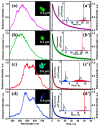HOFs Built from Hexatopic Carboxylic Acids: Structure, Porosity, Stability, and Photophysics
- PMID: 35216044
- PMCID: PMC8875020
- DOI: 10.3390/ijms23041929
HOFs Built from Hexatopic Carboxylic Acids: Structure, Porosity, Stability, and Photophysics
Abstract
Hydrogen-bonded organic frameworks (HOFs) have attracted renewed attention as another type of promising candidates for functional porous materials. In most cases of HOF preparation, the applied molecular design principle is based on molecules with rigid π-conjugated skeleton together with more than three H-bonding groups to achieve 2D- or 3D-networked structures. However, the design principle does not always work, but results in formation of unexpected structures, where subtle structural factors of which we are not aware dictate the entire structure of HOFs. In this contribution, we assess recent advances in HOFs, focusing on those composed of hexatopic building block molecules, which can provide robust frameworks with a wide range of topologies and properties. The HOFs described in this work are classified into three types, depending on their H-bonded structural motifs. Here in, we focus on: (1) the chemical aspects that govern their unique fundamental chemistry and structures; and (2) their photophysics at the ensemble and single-crystal levels. The work addresses and discusses how these aspects affect and orient their photonic applicability. We trust that this contribution will provide a deep awareness and will help scientists to build up a systematic series of porous materials with the aim to control both their structural and photodynamical assets.
Keywords: hexatopic carboxylic acids; hydrogen-bonded organic frameworks; photophysics; porosity; stability; time-resolved spectroscopy.
Conflict of interest statement
The authors declare no conflict of interest.
Figures













Similar articles
-
A Water-Stable Hydrogen-Bonded Organic Framework (HOF) for Selective Sensing of Antibiotics in Aqueous Medium.Chemistry. 2025 Mar 20;31(17):e202404756. doi: 10.1002/chem.202404756. Epub 2025 Feb 11. Chemistry. 2025. PMID: 39888596
-
Design Rules of Hydrogen-Bonded Organic Frameworks with High Chemical and Thermal Stabilities.J Am Chem Soc. 2022 Jun 22;144(24):10663-10687. doi: 10.1021/jacs.2c02598. Epub 2022 Jun 8. J Am Chem Soc. 2022. PMID: 35675383 Review.
-
Exploring Multifunctional Hydrogen-Bonded Organic Framework Materials.Acc Chem Res. 2022 Dec 20;55(24):3752-3766. doi: 10.1021/acs.accounts.2c00686. Epub 2022 Dec 1. Acc Chem Res. 2022. PMID: 36454588
-
Designing Hydrogen-Bonded Organic Frameworks (HOFs) with Permanent Porosity.Angew Chem Int Ed Engl. 2019 Aug 12;58(33):11160-11170. doi: 10.1002/anie.201902147. Epub 2019 May 17. Angew Chem Int Ed Engl. 2019. PMID: 30891889 Review.
-
Macrocycle-Based Hierarchically Porous Hydrogen-Bonded Organic Frameworks.Chemistry. 2024 Mar 7;30(14):e202303618. doi: 10.1002/chem.202303618. Epub 2024 Jan 10. Chemistry. 2024. PMID: 38117667 Review.
Cited by
-
An n-type semiconducting diazaporphyrin-based hydrogen-bonded organic framework.Chem Sci. 2024 Jul 11;15(32):12922-12927. doi: 10.1039/d4sc03455d. eCollection 2024 Aug 14. Chem Sci. 2024. PMID: 39148781 Free PMC article.
-
Tuning of a Hydrogen-Bonded Organic Framework by Liquid-Assisted Mechanosynthesis between Trans-Aconitic Acid and Isonicotinamide.Chemistry. 2025 Jan 17;31(4):e202403427. doi: 10.1002/chem.202403427. Epub 2024 Dec 18. Chemistry. 2025. PMID: 39660640 Free PMC article.
-
Supramolecular Hydrogen Bonding Assembly from Non-Coplanar Aromatic Tetra-1H-Pyrazoles with Crystallization-Induced Emission (CIE).Int J Mol Sci. 2022 Apr 11;23(8):4206. doi: 10.3390/ijms23084206. Int J Mol Sci. 2022. PMID: 35457024 Free PMC article.
References
Publication types
MeSH terms
Substances
Grants and funding
LinkOut - more resources
Full Text Sources
Research Materials
Miscellaneous

